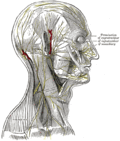Head
Head
The head is the part of an organism which usually includes the brain, eyes, ears, nose and mouth, each of which aid in various sensory functions such as sight, hearing, smell, and taste, respectively.<ref>https://www.wikimd.com/wiki/Head</ref> Some very simple animals may not have a head, but many bilaterally symmetric forms do, regardless of actual complexity.
Anatomy[edit]
The human head consists of a brain, usually three sense organs, one bilateral, two eyes, and two ears, plus three collective sense organs, one mouth, one nose, and one tongue.
Brain[edit]
The brain is an organ that serves as the center of the nervous system in all vertebrate and most invertebrate animals. It is located in the head, usually close to the sensory organs for senses such as vision.
Eyes[edit]
The eye is a sensory organ that allows vision. Rod and cone cells in the retina allow conscious light perception and vision including color differentiation and the perception of depth.
Ears[edit]
The ear is the organ that detects sound. It not only receives sound, but also aids in balance and body position.
Nose[edit]
The nose is the organ that allows for the sense of smell. The cavity of the nose is lined with mucous membranes that have smell receptors connected to the olfactory nerve.
Mouth[edit]
The mouth is the first part of the alimentary canal that receives food and produces saliva. The mouth also contains the tongue and the teeth.
Function[edit]
The head houses the brain which controls the body. The head is also the sensory interface with the environment, collecting information from the senses of sight, smell, taste, touch, and hearing.
See also[edit]
References[edit]
<references />
|
|
|
-
Portrait of a Meerkat
-
Beethoven death mask
-
View of a Skull III
-
Bartholin head transect
-
Nomada krugii, F, face, Dominican Republic
-
Flag of Corsica
-
Leonardo da Vinci, Study on the proportions of head and eyes
-
Domenico Beccafumi - Tête de jeune homme
-
Head nerves
-
Andrea Vaccaro, Tête de Saint-Jean Baptiste
-
Statue de Saint Solange
Ad. Transform your life with W8MD's Budget GLP-1 injections from $75


W8MD offers a medical weight loss program to lose weight in Philadelphia. Our physician-supervised medical weight loss provides:
- Weight loss injections in NYC (generic and brand names):
- Zepbound / Mounjaro, Wegovy / Ozempic, Saxenda
- Most insurances accepted or discounted self-pay rates. We will obtain insurance prior authorizations if needed.
- Generic GLP1 weight loss injections from $75 for the starting dose.
- Also offer prescription weight loss medications including Phentermine, Qsymia, Diethylpropion, Contrave etc.
NYC weight loss doctor appointmentsNYC weight loss doctor appointments
Start your NYC weight loss journey today at our NYC medical weight loss and Philadelphia medical weight loss clinics.
- Call 718-946-5500 to lose weight in NYC or for medical weight loss in Philadelphia 215-676-2334.
- Tags:NYC medical weight loss, Philadelphia lose weight Zepbound NYC, Budget GLP1 weight loss injections, Wegovy Philadelphia, Wegovy NYC, Philadelphia medical weight loss, Brookly weight loss and Wegovy NYC
|
WikiMD's Wellness Encyclopedia |
| Let Food Be Thy Medicine Medicine Thy Food - Hippocrates |
Medical Disclaimer: WikiMD is not a substitute for professional medical advice. The information on WikiMD is provided as an information resource only, may be incorrect, outdated or misleading, and is not to be used or relied on for any diagnostic or treatment purposes. Please consult your health care provider before making any healthcare decisions or for guidance about a specific medical condition. WikiMD expressly disclaims responsibility, and shall have no liability, for any damages, loss, injury, or liability whatsoever suffered as a result of your reliance on the information contained in this site. By visiting this site you agree to the foregoing terms and conditions, which may from time to time be changed or supplemented by WikiMD. If you do not agree to the foregoing terms and conditions, you should not enter or use this site. See full disclaimer.
Credits:Most images are courtesy of Wikimedia commons, and templates, categories Wikipedia, licensed under CC BY SA or similar.
Translate this page: - East Asian
中文,
日本,
한국어,
South Asian
हिन्दी,
தமிழ்,
తెలుగు,
Urdu,
ಕನ್ನಡ,
Southeast Asian
Indonesian,
Vietnamese,
Thai,
မြန်မာဘာသာ,
বাংলা
European
español,
Deutsch,
français,
Greek,
português do Brasil,
polski,
română,
русский,
Nederlands,
norsk,
svenska,
suomi,
Italian
Middle Eastern & African
عربى,
Turkish,
Persian,
Hebrew,
Afrikaans,
isiZulu,
Kiswahili,
Other
Bulgarian,
Hungarian,
Czech,
Swedish,
മലയാളം,
मराठी,
ਪੰਜਾਬੀ,
ગુજરાતી,
Portuguese,
Ukrainian














